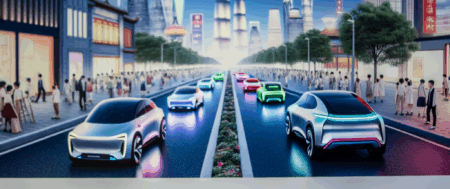China, the world’s top and largest automotive market, is driven by a growing economy, urbanization, and a burgeoning urban middle class, favoring both domestic car brands and foreign automakers. The market is rapidly evolving, with electric vehicles (EVs) and new energy vehicles (NEVs) at the forefront, thanks to environmental concerns and robust government incentives. This push towards sustainable mobility has made China a pivotal player in the EV revolution, influencing global automotive trends. Foreign automakers looking to penetrate this lucrative market often engage in joint ventures with local firms to comply with the complex regulatory landscape, cater to consumer preferences for cutting-edge technology, and remain competitive. Understanding market dynamics, consumer behavior, and technological advancements is crucial for success in China’s competitive automotive industry, especially in the EV and NEV sectors. Strategic partnerships and a deep grasp of the regulatory environment are essential for tapping into the opportunities presented by China’s automotive market, setting a precedent for future global mobility trends.
In the fast-paced world of automotive excellence, China stands as the reigning champion, boasting the title of the largest automotive market globally. This prestigious position is not just a testament to its sheer volume in production and sales but also highlights its pivotal role in shaping the future direction of the automotive industry. With a rapidly growing economy powering its ascent, the emergence of a burgeoning middle class, and the relentless march of urbanization, China’s automotive landscape is a dynamic theatre of innovation, competition, and strategic maneuvering. At the heart of this evolution is the country’s fervent push towards Electric Vehicles (EVs) and New Energy Vehicles (NEVs), driven by a mixture of government incentives, environmental concerns, and consumer preferences which are collectively steering the global trends towards greener transportation solutions.
The allure of China’s automotive market is magnetic, attracting both domestic car brands and foreign automakers, each vying for a slice of this lucrative pie. However, navigating the complex regulatory landscape requires astute strategic partnerships, often manifesting as joint ventures between foreign entities and local Chinese companies. This symbiosis is crucial for accessing China’s vast consumer base while aligning with the country’s ambitious environmental and economic goals.
This article delves deep into the intricacies of China’s automotive dominance, exploring the surge in Electric Vehicles (EVs), the strategic importance of New Energy Vehicles (NEVs), and the indispensable role of joint ventures in bridging cross-border automotive ambitions. We will unravel how foreign automakers and domestic car brands are adapting to regulatory challenges, the economic and urbanization factors fueling automotive demand, and how government incentives are electrifying the push towards EVs in urban centers. Furthermore, we will examine the technological advancements, consumer preferences, and strategic partnerships that are driving market competition and innovation.
Understanding China’s automotive market is paramount for any stakeholder looking to navigate its complexities and capitalize on its opportunities. Join us as we explore the engines of growth, the roadmap to green transportation, and the alliances shaping success in the world’s top automotive arena.
1. “Navigating the World’s Top Automotive Arena: Understanding China’s Market Leadership and the Surge in Electric Vehicles (EVs)”

Navigating the global automotive landscape, it becomes clear why China holds the title of the world’s top and largest automotive market. This prestigious position is the result of a confluence of factors, including its rapidly growing economy, the significant expansion of the urban middle class, and accelerated urbanization rates. These elements combine to create a fertile ground for both domestic car brands and foreign automakers to thrive. However, the surge in electric vehicles (EVs) and new energy vehicles (NEVs) is particularly noteworthy, marking a significant shift in consumer preferences and the automotive industry’s trajectory.
The pivot towards EVs and NEVs in China is not merely a trend but a movement, driven by environmental concerns and robust government incentives. The Chinese government has been at the forefront, implementing policies that encourage the production and adoption of cleaner, more sustainable vehicles. These initiatives have not only aligned with global efforts to combat climate change but have also positioned China as a leader in the electric vehicle revolution.
Foreign automakers looking to tap into China’s lucrative market face a complex regulatory landscape. To navigate these challenges, many choose to form joint ventures with local Chinese companies. These strategic partnerships are crucial, enabling international brands to gain access to the vast consumer base while adhering to local regulations and standards. Joint ventures also facilitate a sharing of technology and resources, driving innovation and competition within the market.
Understanding consumer preferences is equally vital in this competitive environment. Chinese consumers are increasingly sophisticated, with a growing demand for high-quality, technologically advanced vehicles. This shift is a reflection of the broader technological advancements within the country and the automotive industry at large. Consequently, companies that can offer innovative features, enhanced connectivity, and greener options are more likely to capture the attention and loyalty of customers.
The competition in China’s automotive market is fierce, with domestic and foreign brands vying for a larger share of the pie. Success in this market is not guaranteed and requires a deep understanding of the regulatory environment, consumer behavior, market trends, and the ability to form and maintain strategic partnerships. For companies willing to invest the time and resources, the rewards can be substantial, given the market’s vast size and potential for continued growth.
In summary, China’s leadership in the automotive sector, particularly in the EV and NEV market, is a testament to its evolving economy, technological prowess, and the strategic interplay of government policies and incentives. As environmental concerns continue to drive global market trends, China’s automotive industry stands at the forefront, shaping the future of mobility both domestically and internationally.
In conclusion, the dominance of China as the world’s top automotive arena is unmistakable, driven by its status as the largest automotive market globally. This market’s exponential growth is fueled by a combination of factors including a rapidly growing economy, increasing urbanization, and a burgeoning middle class with an appetite for both domestic car brands and foreign automakers. The shift towards Electric Vehicles (EVs) and New Energy Vehicles (NEVs), supported by robust government incentives and rising environmental concerns, is redefining the landscape, positioning China as a leader in the global shift towards greener transportation.
The intricate regulatory landscape of China demands that foreign automakers enter strategic partnerships, often in the form of joint ventures, with local Chinese companies. This collaboration is essential not just for navigating the complex market but also for tapping into the vast consumer base that is increasingly leaning towards EVs and NEVs. These partnerships, coupled with an understanding of consumer preferences, technological advancements, and market competition, are key to thriving in this dynamic market.
China’s automotive market is at the forefront of technological innovation, driven by both government policies and consumer demand for more sustainable and advanced transportation options. The emphasis on EVs and NEVs showcases China’s commitment to combating environmental concerns while also catering to the global demand for cleaner energy sources in transportation.
For companies looking to succeed in China’s competitive automotive sector, a deep understanding of the market’s regulatory landscape, consumer behavior, and the importance of forming strategic partnerships is crucial. As the market continues to evolve, driven by technological advancements, environmental policies, and changing consumer preferences, the opportunities for growth in China’s automotive industry remain vast. The future of the global automotive industry undeniably runs through China, making it a pivotal market for any automotive player aiming for global relevance.







